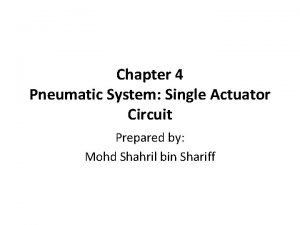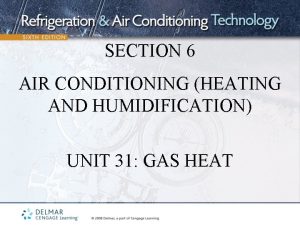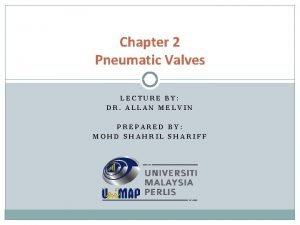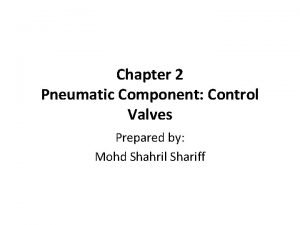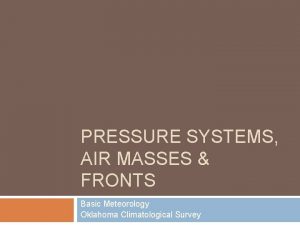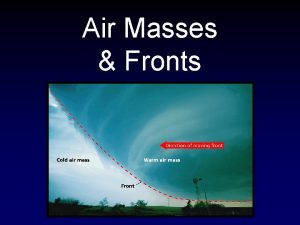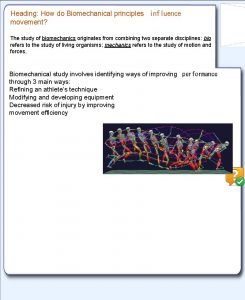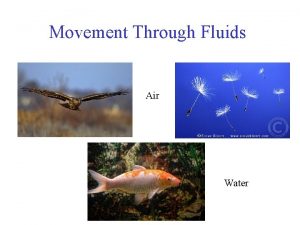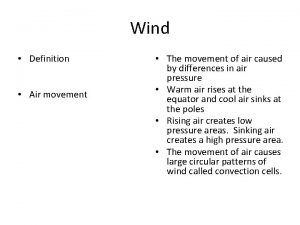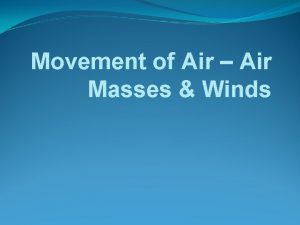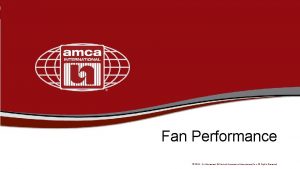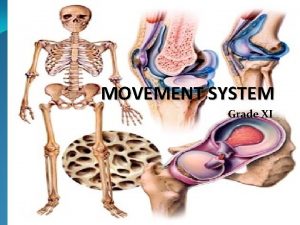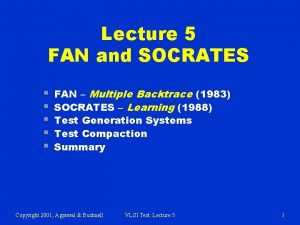AIR MOVEMENT AND FAN TECHNOLOGY FAN PRINCIPLES THE
































- Slides: 32

AIR MOVEMENT AND FAN TECHNOLOGY

Ø FAN PRINCIPLES Ø THE FAN LAWS Ø OPERATION OF FAN Ø FAN SELECTION

OBJECTIVE TO INTRODUCE �� Understanding of essential fan concepts �� Fan Types �� Fan Performance Curves �� Fan Selection Factors § TO ESTIMATE �� calculation for fan selection. �� how to plot the fan curve graph. �� fan law. §

INTRODUCTION q A fan is the prime mover of an air system or ventilation system. q It moves the air land provides continuous air flow that the conditioned air, space air, exhaust air, or outdoor air can be transported from one location to another through air ducts or other air passages. q Fans can mounted individually as ventilating equipment to provide outdoor air movement inside a building. q It can also transport air containing dust particles or material from one place to another via air duct systems. q In air conditioning systems, fans are often installed in air-handling units (AHU), package units, or other air conditioning equipment.

DIFFERENCE BETWEEN FAN AND BLOWER Ø These are some differences in the designs and applications of fan and blower. Ø The primary differences are in – Physical construction – The pressures which they are designed to develop

v FAN - It is designed to operate at small static pressure, up to 2. 0 psi (13. 8 k. Pa) - Typical operating pressure is from 0 to 6 in water gage (0. 217 psi or 1500 Pa). v BLOWER - Typical operating pressure is from 2 psi to approximately 10 psi.

TERMINOLOGY • CFM (Cubic Feet per Minute) Unit of measure for flow rate • SP (Static Pressure) Measurement for resistance to flow Typically measured in inches of water gauge (“ w. g. ) • HP (Horsepower) Unit of measure for power Typically refers to a nominal or nameplate value

• BHP (Brake Horsepower) Unit of measure of power It is the actual power required for a specific performance • Outlet Velocity of air through the discharge of a fan Typically measured in feet per minute (fpm)

FAN PRINCIPLES & OPERATION FAN

FAN PRINCIPLE Ø TYPES OF FAN ARE…. • Axial. • Centrifugal. • Propeller. • Mixed Flow. • Cross Flow.

AXIAL FAN ØThe term, axial, refers to the use of a set of fan blades mounted on a rotating shaft. Ø A standard house ventilation fan is an axial fan. Ø has an impeller fitted with aerofoil blades mounted on a hub rotating mounted in line with the direction of air flow within a cylindrical casing. Ø The motor is usually coupled directly to the impeller which therefore must rotate at motor speed. Ø the motor can be mounted either externally, with the impeller being belt driven through the casing, or by bifurcating the fan casing.

AXIAL FAN

AXIAL FAN COMPONENTS

CENTRIFUGAL FAN Ø Has a fan wheel composed of a number of fan blades mounted around a hub. Ø Generate high-pressure rises in the gas stream. Ø Centrifugal fans have blades mounted on an impeller something like an old fashioned water wheel. Ø The impeller is mounted within a volute or scroll casing and can be forward, backward or radial (paddle) bladed. Ø The air enters along the line of the drive shaft and leaves at 90° to the entering air. Ø These are by far the most common types of fan used for air conditioning.

CENTRIFUGAL FAN


CENTRIFUGAL FAN TYPES BLADE TYPE CHARACTERISTICS FORWARD Backward Curved high efficiency high speed noisy large size high cost self limiting power RADIAL BACKWARD Forward Curved low efficiency low speed quiet small size low cost sharply rising power


v Centrifugal fans use a rotating impeller to increase velocity of an airstream. Air moves from the impeller hub to blade tips, gaining kinetic energy. – Generate high pressures. – Frequently used in • “dirty” airstreams (high moisture & particulates), • material handling applications, • higher temperatures.

v Axial fans move an airstream along the axis of the fan. Air is pressurized by the aerodynamic lift generated by the fan blades, like a propeller & an airplane wing. – Used in “clean air, ” low-pressure, high volume applications. – Less rotating mass, more compact than centrifugal fans of comparable capacity. – Higher rotational speeds, noisier than in-line centrifugal fans of the same capacity.

PROPELLER • A propeller is a device which transmits power by converting it into thrust for propulsion of a vehicle such as an airplane, ship, or submarine though a fluid such as water or air, by rotating two or more twisted blades about a central shaft, in a manner analogous to rotating a screw through a solid. • The blades of a propeller act as rotating wings, and produce force via Bernoulli's principle, generating a difference in pressure from the forward and rear surfaces of the airfoil-shaped blades

PROPELLER


• The fan normally consists of a "flat" frame or housing for mounting, a propeller-shaped blade, and a drive motor. Propeller fan characteristics are summarized in Table at the next slide.

Typical characteristics of propeller fans Motor horsepower 1/100 to 5 hp Blade diameter 6 to 72 in. Static pressures 0 to 0. 5 in. H 2 O Drive Direct or belt Common uses Livestock building ventilation and air circulation.

- There are only three basic important shapes that are of interest in the propeller selection - round, wide pressure and narrow pressure blades. q The round shaped blades are for used for free air delivery and low pressure applications, and are quieter. q The wide pressure blade is used in most applications operating at substantial static pressures. It has excellent pressure characteristics and reasonable noise levels. q The narrow pressure blade is generally used in applications where high static pressure exists, such as multi-row coils or places where minimum axial depth is necessary.


CROSS FLOW üThis type normally has a long cylindrical impeller having a relatively large number of shallow forward curve blades. üDue to the shape of the casing surrounding this impeller, air enters all along one side of the cylindrical surface of the impeller and leaves on another side.

CROSS FLOW


MIXED FLOW § A fan in which the air path through the impeller is intermediate between the axial and centrifugal types giving the benefit of increased pressure but capable of being constructed to provide either axial or radial discharge.

MIXED FLOW
 Fanin and fanout in cmos
Fanin and fanout in cmos Electrons flowing
Electrons flowing Air higroskopis adalah
Air higroskopis adalah Light gun signals
Light gun signals Air movement and control association
Air movement and control association Axial dance movement
Axial dance movement Single acting cylinder pneumatic circuit
Single acting cylinder pneumatic circuit Return air and supply air
Return air and supply air Supply air throttling and exhaust air throttling
Supply air throttling and exhaust air throttling Pneumatic sequence valve
Pneumatic sequence valve Measures air temperature
Measures air temperature Warp knitting examples
Warp knitting examples Horizontal movement of air
Horizontal movement of air Air that resists vertical movement is said to be
Air that resists vertical movement is said to be Occluded front
Occluded front Cold front air movement
Cold front air movement Easterlies and westerlies
Easterlies and westerlies Vertical air movement
Vertical air movement Automotive technology principles diagnosis and service
Automotive technology principles diagnosis and service How do biomechanical principles influence movement
How do biomechanical principles influence movement Value rhythm art
Value rhythm art Forced passive movement
Forced passive movement Biomechanical principles pdhpe
Biomechanical principles pdhpe Hình ảnh bộ gõ cơ thể búng tay
Hình ảnh bộ gõ cơ thể búng tay Ng-html
Ng-html Bổ thể
Bổ thể Tỉ lệ cơ thể trẻ em
Tỉ lệ cơ thể trẻ em Chó sói
Chó sói Thang điểm glasgow
Thang điểm glasgow Hát lên người ơi
Hát lên người ơi Môn thể thao bắt đầu bằng từ đua
Môn thể thao bắt đầu bằng từ đua Thế nào là hệ số cao nhất
Thế nào là hệ số cao nhất Các châu lục và đại dương trên thế giới
Các châu lục và đại dương trên thế giới






